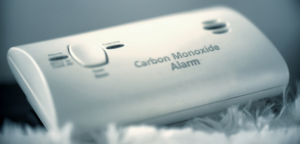The most common cause of hazardous gas furnaces or boilers is cracked heat exchangers, which typically occur in furnaces older than 10 years. It is highly recommended to have a functioning carbon monoxide detector installed near your gas heater to ensure your safety.
Be warned of a possible carbon monoxide leak from a cracked heat exchanger in a gas heating unit
It is important to plan and schedule an HVAC system replacement to avoid any issues with the heating exchanger or other failures during the cold winter months. If you encounter any major problems, it is best to seek the assistance of a qualified HVAC technician for service.
We would like to emphasize that the furnace in the basement or mechanical room could often be unattended for a while. Therefore, EMCO Tech recommends visually checking the HVAC system before every season. Additionally, you should consider signing up for gas heater and air conditioner service agreement with us and let EMCO Tech contractors do all the work. Gas-fueled appliances could become dangerous carbon monoxide poisoning machines if not maintained regularly. It is important to keep your home’s heating system serviced regularly. Failure to maintain HVAC units and promptly address any malfunctions can lead to health hazards caused by a malfunctioning furnace. However, if you handle your gas furnace appropriately and have it serviced periodically, you don’t have to worry about its performance.
What is a Heat Exchanger?
A Heat Exchanger is a crucial component of any gas furnace system. It is an internal part of the HVAC system that heats the indoor air. The gas combustion chamber transfers the heat to the air that comes from the blowing fan. Then, it moves into the living spaces through the air duct system. The combustion gases never come into contact with the indoor air. If the Heat Exchanger has cracks, hazardous fumes can fill up the living spaces. The heat emitted by the combustion gas increases the Heat Exchanger’s temperature, and the air from the blower passes through it, transferring the heat into it.
What are the consequences of having a cracked heat exchanger?
Exhaust fumes that contain carbon monoxide can seep into the air through cracks that develop on metal. Carbon monoxide is a poisonous gas that has no smell or taste. Inhaling it can make you sick, and exposure to high levels can be fatal. According to the National Center for Environmental Health, every year, at least 430 people die in the U.S. due to accidental CO poisoning. Approximately 50,000 people in the U.S. visit the emergency department each year due to accidental CO poisoning. However, there are steps you can take servicing gas furnace to protect yourself and your household from CO poisoning.
Understanding the Causes and Signs of Cracked Heat Exchangers
Cracks in heat exchangers are mainly caused by corrosion. This corrosion weakens the metal of the heat exchanger over time. The main cause is a gradual reaction between the combustion gas and the metal. Therefore, it is important to pay close attention to old furnaces. Also, never ignore even the smallest crack, as they will eventually widen as the heat exchanger operates.
Contact EMCO Tech Heating and Cooling Today
You can easily identify a cracked heat exchanger by listening for a clicking sound produced by the furnace when the blower shuts off. If you are experiencing any issues with your furnace or heat exchanger, it is best to call one of the experts at EMCO Tech (also known as Emergency Maintenance Company) to diagnose and repair the problem.



